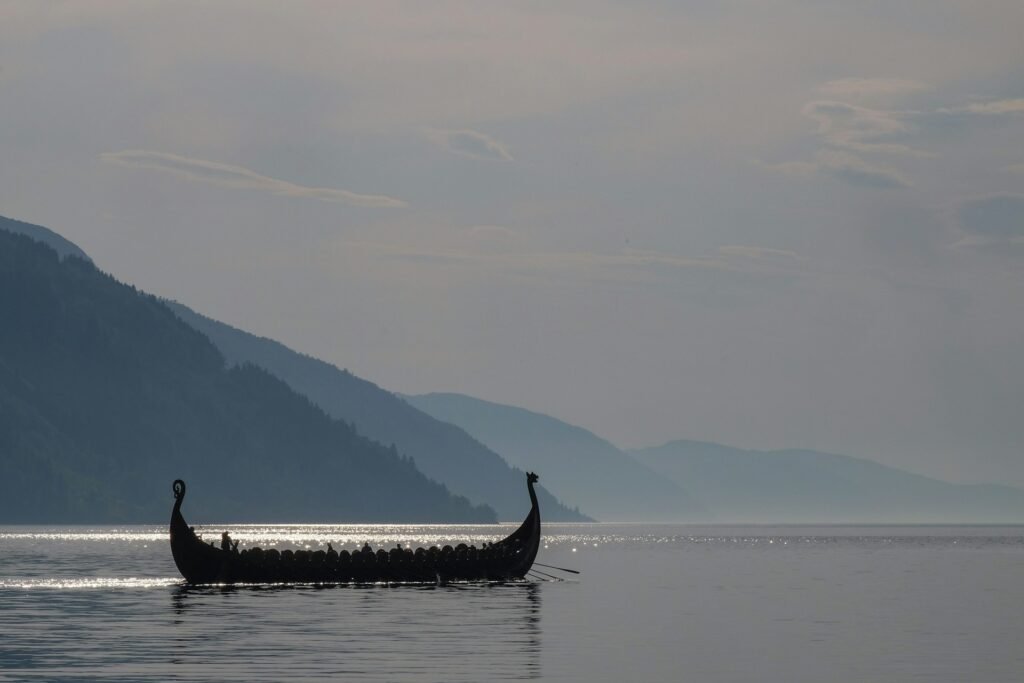

The Fascinating Viking Ship Museum in Oslo: A Glimpse into Norway’s Past
Have you ever wondered what secrets ancient Viking ships could reveal about Norway’s rich maritime history?
The Viking Ship Museum in Oslo opens a door to the past, showcasing the world of the Vikings. It’s known for its rare Viking ships and artifacts, making it a top spot in Oslo. Explore the Viking era and how it influenced Norway and beyond. Ready for a unique trip through Norway’s history?
Table of Contents
ToggleIntroduction to the Viking Ship Museum
The Viking Ship Museum is found on the stunning Bygdøy peninsula. It showcases Norway’s maritime history well. People from all over the world visit to see its wealth of Viking artifacts.
History of the Museum
In the early 20th century, the museum’s story began. It started when three amazing Viking ships were found: the Oseberg, Gokstad, and Tune. People carefully dug these ships up from burial sites. They kept them safe and now we can get an amazing look at Norway’s past. The museum opened in 1926. Since then, its goal has been to protect and show these important parts of Viking life.
Location and Accessibility
The museum is in the heart of Oslo, right on the Bygdøy peninsula. This puts it at the center of culture for people visiting or living nearby. It’s easy to get to by bus, boat, or car. Everyone is welcome at this famous spot. They make sure it’s easy for everyone to enjoy the journey through Norway’s history.
Below is a look at the three main Viking ships in the museum:
| Viking Ship | Year Found | Significance |
|---|---|---|
| Oseberg | 1904 | Elaborate burial ship, highlighting Viking craftsmanship and hierarchical society. |
| Gokstad | 1880 | Known for its robust construction, it offers insights into Viking maritime prowess and warrior culture. |
| Tune | 1867 | Valuable for understanding Viking shipbuilding techniques and practical seafaring skills. |
Diving into Norwegian History
Exploring Norway’s history shows a deep link to the sea, especially during the Viking Age. This was a time when stories of epic journeys spread far and wide.
Norway’s Maritime Heritage
Norway’s past is tied strongly to the sea. The Viking Ship Museum in Oslo shows this well. It has many well-preserved Viking ships, displaying their sailing adventures. These ships were not just for show; they were used for trade all over Europe.
The museum gives us a peek into Viking life. We see evidence of the brave seafaring journeys they undertook. These tales have lived on, becoming legendary in Norse history.
The Role of Vikings in Scandinavian History
Vikings were key to shaping Scandinavian history. Their bold journeys reached far and wide, impacting many cultures. The museum helps us understand how Vikings changed the world around them.
Examining the museum’s artifacts lets visitors see the vast Viking reach. They established strong connections wherever they went. This had a lasting effect on Scandinavia’s development.
| Aspect | Details |
|---|---|
| Maritime Innovations | Advanced shipbuilding techniques and navigational skills |
| Trade Routes | Extensive trading networks connecting Europe |
| Cultural Impact | Blending of Norse traditions with local customs |
| Exploration | Iconic voyages across the Atlantic |
The Viking Ship Museum beautifully shares the story of Norway’s sea legacy. It shows the Vikings’ significant role in European history. This makes it a must-visit for those interested in this exciting era.
Discovering the Viking Ships
The Viking Ship Museum boasts a stunning array of Viking ships, very well-preserved. These *archaeological treasures* shed light on Viking craftsmanship and their sailing skills.
Looking closely, visitors will be amazed at the detailed design and building methods of the Vikings. Beyond just boats, these artifacts share the story of a bustling culture. The ships’ design hints at the Vikings’ everyday life, rituals, and their rule of the seas.
Each ship stands out with its own special features, like intricate carvings and sturdy hulls, showing the Vikings’ strong sea bond. While exploring, one might imagine the sailors braving the unknown with these very *archaeological treasures*.
The museum also provides a lesson on the historical value of these *Viking ships*. It shows their role in trade, discovery, and war. This educational adventure deepens knowledge of Viking maritime culture and honors their creativity and history.
The Oseberg Ship: A Masterpiece of Viking Engineering
The Oseberg Ship shows off the skill of Viking engineering. It is a beautiful example of the era’s work. It was found in a mound in Norway, showing off a mix of function and beauty from the Viking Age.
Construction and Design
The Oseberg Ship is known for its detailed design and sturdy build. It’s mostly made of oak and is about 70 feet long and 17 feet wide. Its elegant shape and carvings were not just pretty but helped it sail well.
- Length: 70 feet
- Width: 17 feet
- Primary Material: Oak
Artifacts Found with the Oseberg Ship
There were amazing finds in the burial mound with the ship. The items, like rich textiles, fancy household tools, and ceremony stuff, tell us a lot about Viking life. They give us clues about how they lived and their social structure.
| Type of Artifact | Description |
|---|---|
| Textiles | Richly decorated woven fabrics possibly used in ceremonial contexts |
| Household Utensils | Elaborate utensils suggesting high status |
| Ceremonial Items | Objects likely used in religious or ceremonial practices |
The Gokstad Ship: A Warrior’s Vessel
The Gokstad Ship is a true wonder of Viking skill and power. It was found in the 19th century, hidden in a big burial mound. This ship was built to be both fast and tough. Its design shows it was made for quick travel and strong fighting.
Significance and History
The Gokstad Ship is an important part of Norwegian and Viking history. It was made around 890 AD. This ship tells us a lot about how the Norse people built their boats and lived at sea. It was used for traveling and for battles, showing the Vikings were always ready for fight.
The ship was found in a burial mound near Sandefjord, Norway. This placing tells us the person buried with it was very important. They took the ship to the afterlife, showing its special meaning. The Gokstad Ship also lets us look deeply into Viking life, both for daily traveling and for war.
| Feature | Details |
|---|---|
| Length | 23.24 meters (76.2 feet) |
| Width | 5.10 meters (16.7 feet) |
| Construction Material | Oak |
| Discovered | 1880, near Sandefjord |
| Built | Circa 890 AD |
Understanding the Tune Ship
The Tune Ship shows off the amazing shipbuilding skills of the Vikings. Although not as famous as some Viking ships, it teaches us a lot about their sailing ways. This ship is key to know how the Vikings changed their ships for the sea.
The Tune Ship was created with smart thinking and hard work. Viking builders were very skilled at making ships that could handle different seas. The Tune Ship teaches us a lot about Viking ships and how important they were for daily life and voyages.
| Feature | Tune Ship | Comparison with Other Viking Ships |
|---|---|---|
| Construction Material | Wood | Similar to Oseberg and Gokstad ships |
| Design Purpose | Seafaring Adaptability | Varied from ceremonial to warrior vessels |
| Preservation | Partially Preserved | Generally well-preserved examples |
The Tune Ship is a great example of Viking craft. It shows their power on the seas during the Viking Age. By looking at this ship, we learn a lot about how the Vikings sailed and lived.
Scandinavian Artifacts: More Than Just Ships
The Viking Ship Museum is more than just big boats. It shows a wide selection of Scandinavian artifacts. These artifacts give us a deep look into Viking life and culture. They show us how the Vikings did many things in their daily lives.
Daily Life Items
One of the most fascinating parts of the museum features daily life items from the Viking age. This includes clothes, pots, and tools they used at home. We can see how skilled the Vikings were in their daily tasks. It shows a society where beauty and use were equally important.
Weapons and Tools
A big part of the museum is filled with Viking weaponry and tools. Guests can see swords, axes, and shields up close. These items show the Vikings were great fighters. They also demonstrate their expertise in making things out of metal and wood, which was important for their lives.
Immersive Experiences at the Viking Ship Museum
The Viking Ship Museum takes visitors on a special journey. It goes beyond the usual museum visit. Now, history interacts with the present through modern tech.
Interactive Exhibits
These exhibits at the museum are for all ages. You can learn about the Viking Age through fun activities. For instance, you can virtually build a ship or get a close look at ancient items. These hands-on experiences make history both enjoyable and unforgettable.
Virtual Reality Tours
The museum also offers virtual reality tours. By putting on VR headsets, you’re transported to the Viking era. Imagine exploring a Viking ship or being part of a village ceremony. These tours not only add to the fun but also deepen your understanding of the past, connecting with the museum’s collection in a whole new way.
| Feature | Description | Visitor Engagement |
|---|---|---|
| Interactive Exhibits | Hands-on activities and multimedia displays | High |
| Virtual Reality Tours | VR headsets for time-travel experiences | Very High |
Educational Opportunities: Learning Through Exploration
The Viking Ship Museum is a hub for learning exploration. It offers educational chances for all ages. This focus on educational tourism brings forth interactive and fun programs.
Guided tours are a highlight here. They go deep into the Viking Age, sharing intriguing historical facts. These tours are made for kids, teenagers, and adults, ensuring everyone learns something new.
Moreover, the museum runs workshops. These hands-on activities teach about Viking ship-making, old ways to navigate, and crafting. This kind of learning helps people really get the Viking era.
Special programs are also big at the museum. They’re designed to fit with school lessons. This makes the museum a top choice for school educational tourism visits.
The Viking Ship Museum is all about learning exploration. It aims for every visitor to better understand Viking culture and history. This enriches their educational experience.
Overseas Influence: The Museum’s Global Impact
The Viking Ship Museum in Oslo is a leading light in exploring cultures. It often goes beyond Norway. This has helped it build a name worldwide.
International Collaborations
The museum has joined hands with big names like the British Museum and the Smithsonian. These connections have made the Viking Ship Museum more powerful. They help share Viking history globally. Thanks to such partnerships, the museum lights the way for exploring Viking history worldwide.
Global Exhibitions
The museum makes its mark by taking part in exhibitions around the globe. Its treasures have been seen from New York to Tokyo. These shows help people learn about Viking life and sea adventures.
Millions visit these exhibits. And they often get a lot of attention in the news. This shows how important spreading culture is. It also highlights the museum’s key role in global history.
Visitor Information and Tips
Planning your trip well can make your visit to the Viking Ship Museum truly enriching. We’ve put together some tips and info to help.
Best Time to Visit
Visit between June and August for the best weather and longer days. But if you prefer fewer people, try April-May or September-October. Weekdays are less crowded than weekends and holidays.
Guided Tours
For a deeper look at the museum, join a guided tour. You’ll learn a lot more with the help of guides. They offer insights into the Viking Age and the museum’s artifacts. Tours are in different languages and bring the museum to life.
| Season | Visitor Experience | Weather |
|---|---|---|
| Summer (June-August) | Busiest with long days | Pleasant |
| Spring (April-May) & Autumn (September-October) | Less crowded | Moderate |
| Winter (November-March) | Least crowded | Cold |
Before your visit, contact the museum or check the official website for detailed info. Enjoy exploring the Viking Ship Museum. Don’t miss out on the insightful guided tours!
The Fascinating Viking Ship Museum in Oslo: A Glimpse into Norway’s Past
The Viking Ship Museum in Oslo is amazing. It shows how Norway’s maritime history was born. Visitors step into Viking times. They see the amazing ship-building skills and learn about Norway’s rich heritage.
This museum has Viking ships that are almost fully intact. They show how skilled the sailors were. The ships tell us about the Vikings’ smart way of building boats and their complex society.
The museum also has items from daily Viking life. You can see tools, weapons, and more. This shows how the Viking Age affected every part of life. It’s a must-see for anyone visiting Oslo and wanting to learn about Norway’s culture.
And that’s not all. The museum lets you really dive into the Viking world. You can use cool technology to immerse yourself in Viking life. This makes learning about the Vikings both fun and educational.
Visiting the Viking Ship Museum in Oslo is a big deal for Norse culture fans. It brings Norway’s past to life. The museum helps everyone understand and enjoy Viking history.
Conclusion
Visiting the Viking Ship Museum in Oslo takes you back in time. It shows the heart of Norway’s sailing history and Viking times. You’ll see the Oseberg, Gokstad, and Tune ships, each telling a story of Viking skills on the sea.
The museum also has many Viking items. These include daily tools, weapons, and more. You can explore these through interactive displays and virtual reality. They make history come alive.
This museum is not just for learning. It shows the Vikings’ lasting impact on the world’s seas. Its work with others globally spreads knowledge about Viking culture.
If you love history or want to explore Norway’s past, this museum is a must-visit. It offers an incredible and educational experience for all.
If you want to learn Norwegian, you can register for classes here. We look forward to hearing from you and helping you become fluent in Norwegian.






